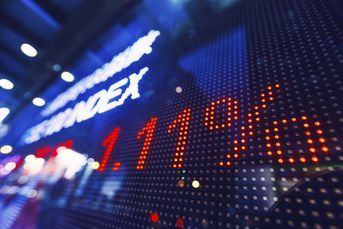Active managers are getting a smaller slice of the pie

The debate over active versus passive strategies may be coming to a close.
A rocky start to the year for the financial markets against the backdrop of surging inflation and higher interest rates would seem to indicate a strong run ahead for active management. The argument typically goes that market volatility, especially the downward kind, is a time for active managers to flex their muscles by teasing out precious alpha as market beta is heading south.
In the wide world of book-talking, that’s often how the story is presented. In the most polished version, active management typically has the best stories of a wizard behind a curtain somewhere helping investors navigate the best and worst of risk and reward.
In reality, only about a third of active strategies manage to beat their benchmarks, regardless of whether it’s a bull or bear market. But these are mostly gross generalizations, because even the simple definition of active and passive management is nuanced to the point of overlapping strategies and definitions. That explains the broad expanse of the never-ending debate about what makes a market, and why there will always be a home somewhere for active management.
“I don’t think active will ever have another opportunity to dominate, but I do believe there are niche areas where active provides real value,” said Steve Skancke, chief economic adviser at Keel Point.
Regarding the current economic backdrop, Skancke said, “I come down on the side of this probably not paving the way for active management.”
ACTIVE CHALLENGES
Skancke cited the pandemic-influenced market volatility that started in early 2020 and went through much of 2021 and said that active, in general, did not step up and deliver outperformance.
“When you look at the S&P 500 Index, it’s really hard to beat that,” he said, adding that the outlook for lower expected returns for the broad market over the next few years will make it even harder for active managers to outperform.
“It will probably be single-digit returns for the next several years just as a result of the uptick in interest rates,” Skancke said. “Historically, when we’ve seen markets in the 8% to 10% range, you typically don’t see active managers outperform, because it’s difficult to cover the higher fees.”
“I don’t think active will ever
have another opportunity
to dominate.”Steve Skancke, chief economic adviser, Keel Point
Don Bennyhoff, chief investment officer at Liberty Wealth Advisors, joined the RIA a year ago after 23 years at indexing giant The Vanguard Group, and his stance on active management is in line with what one might expect.
“We’ve gravitated away from higher cost, and I think everyone understands the relationship between higher cost and lower returns,” he said. “If you’re looking for risk management, active management is a source of risk, not risk management.”
Bennyhoff doesn’t deny there are good active managers, he just thinks the effort to find them isn’t worth it and believes advisers’ time can be better spent elsewhere.
“We try and think about the job at hand, and we don’t use active funds as a risk management tool,” he said. “But to the degree the client wants to outperform, it’s hard to do that with passive funds unless you are willing to be tactical.”
Yes, the notion of being tactical even with a portfolio made up of passive indexed strategies is where the hairs start to split, and the nuance abounds. While it’s prudent to acknowledge the shades of grey overlapping active and passive, the classic, old-school actively managed mutual fund is generally viewed as occupying the opposite end of the continuum from a low-cost index exchange-traded fund.
‘BUYING INTO THE STORY’
Bennyhoff and other passive-investing proponents readily acknowledge the advantages of active management when it comes to select market sectors and industries, mostly involving less-efficient areas such as small-cap equities, emerging markets, international equities, municipal bonds, and fixed income in general.
Beyond that, Bennyhoff said, investors and financial advisers are just “buying into the story of active management.”
“There’s some great managers out there, and I’m not a detractor for active funds,” he said. “I think people buy into the story that if you pay an active manager higher cost, they can give you higher returns. But they only consistently make good on one of those promises, you definitely get higher costs.”
Charles Sachs, chief investment officer at Kaufman Rossin Wealth, is also in the camp of being done with active management and the stories that come with it.
“It’s turnover, taxes and expenses,” he said. “You’re paying someone to do something they shouldn’t be doing. You have the extra cost of the manager, the extra cost of the taxes, and you underperform.”
But while Sachs contends that “it’s just a matter of time before you will have egg on your face as an active manager,” the flip side is what makes a market and keeps pumping life into active strategies.
Bryan Shipley, co-chief executive at Arnerich Massena & Associates, believes his time is well spent researching and allocating to active managers.
“The data says you have about a 50-50 shot of beating benchmark after fees,” he said. “Every year we do a study on ourselves because we want to be sure that we’re adding value to our clients in the managers we approve for our clients.”
Shipley said the extra effort pays off.
“At worst, two-thirds of our managers beat their benchmark after fees, and at best 80% have beaten the benchmark after fees,” he said. “Today, about 10% to 20% of our portfolios are passive. It takes patience to really get rewarded through active management.”
‘TALE OF TWO ASSET CLASSES’
That kind of commitment is likely music to the ears of the active management space, because it’s a rare tune, says Eric Balchunas, senior ETF analyst at Bloomberg Intelligence.
“Last year active management pretty much treaded water, losing about $50 billion worth of net flows, but if you deconstruct that, it’s a tale of two asset classes,” he said.
According to Bloomberg’s data, active equity funds suffered about $400 billion in net outflows in 2021, while active bond funds had net inflows of roughly $350 billion.
“The active exodus is really out of stock pickers,” Balchunas said. “People are just not into paying a legacy money manager, especially the closet indexers. That’s as close as anything to an endangered species.”
But as endangered species go, sitting atop a mountain of assets in the legacy active management space is still far from horrible.
Even as low-cost indexed strategies have become the darlings of independent financial advisers as the foundation of almost any portfolio with a long-term focus, active management still has scale and inertia on its side.
As Balchunas details, the actively managed segment is riding a “bull market subsidy” that could persist until a real bear market takes it away.
“The stock market is up 122% over the last five years,” he said. “If you have a big base of assets in a bull market, there’s nothing greater. It makes you completely immune to outflows.”
Last year, for example, active funds grew by about $12 billion.
“Active outflows are around $2 trillion over the past five years, yet the assets have ballooned by about $5 trillion over that time, so the fee revenue has grown by $45 billion,” Balchunas said. “It doesn’t make sense to the normal mind that you lose customers and make more money. The active slice of the pie keeps shrinking but the pie keeps getting bigger.”
ETF MIGRATION
But while analysts believe the legacy active strategies wrapped inside traditional mutual funds will continue losing to ETFs, the active efforts are far from over, as witnessed by the way active strategies are migrating into the ETF space.
While asset managers cling for all the obvious reasons to high-cost active funds that still generate revenue, they’re also trying to wrap many of those same strategies inside ETFs to have it both ways for as long as it lasts.
“You’re still seeing incremental net gains toward active in traditional wirehouse and full-service brokerage channels, but as you look at the balance of portfolios among the independents, the portfolios are tilted toward passive already,” said Tyler Cloherty, managing director at Casey Quirk.
“The RIAs tend to be much more cost sensitive,” Cloherty added. “There’s definitely a strong performance story where segments have had much less ability to provide alpha over time. But there’s been a bit of behavior tilt by advisers, so they don’t want to spend the bulk of time doing manager research or asset allocation. They’re looking at a mix of betas, rather than looking at managers.”
[MORE: Active ETFs catch the eye of RIAs and big funds, too]
Learn more about reprints and licensing for this article.








